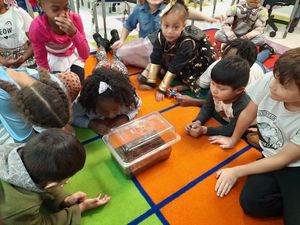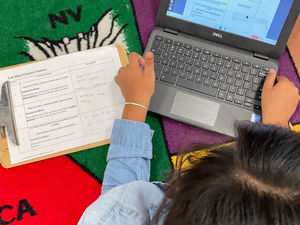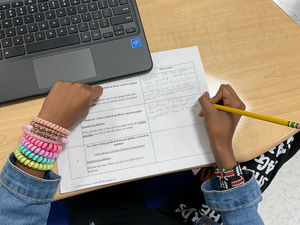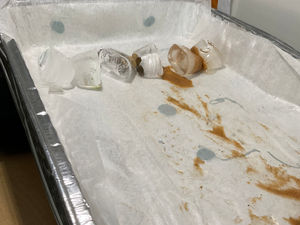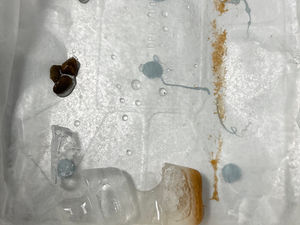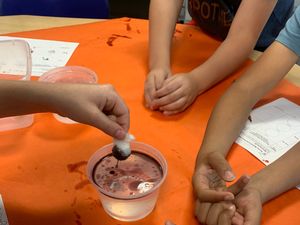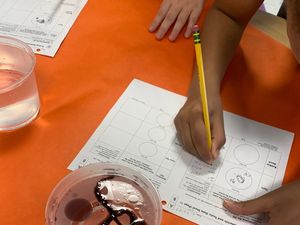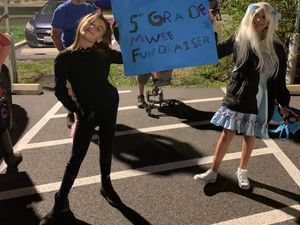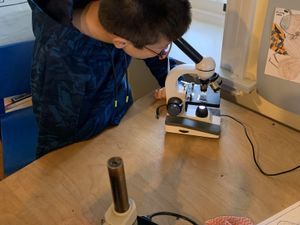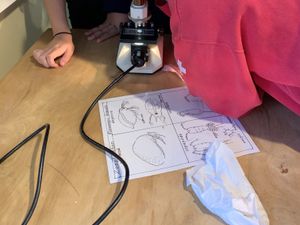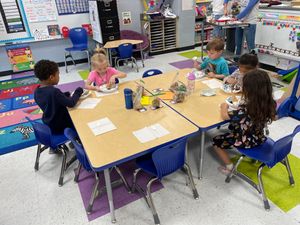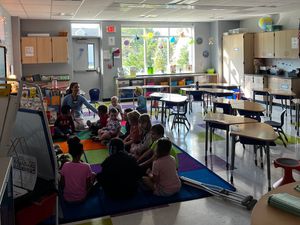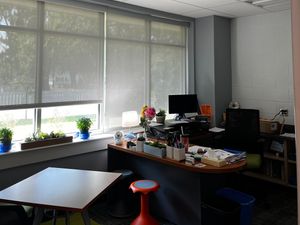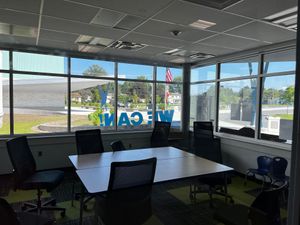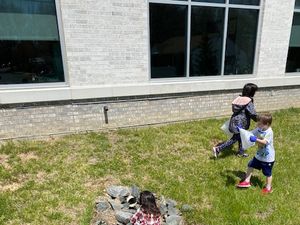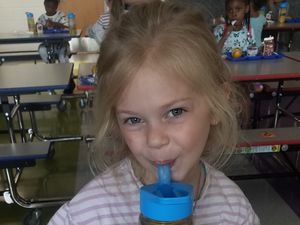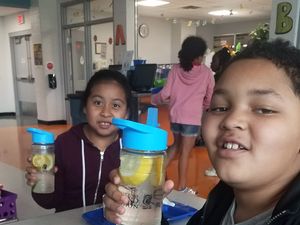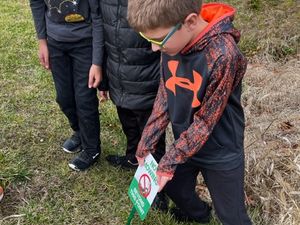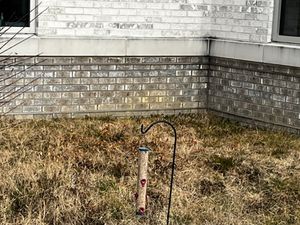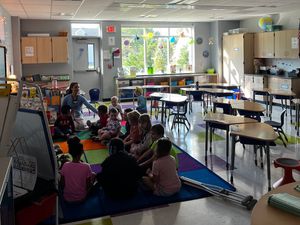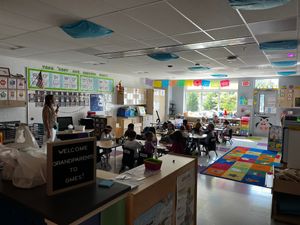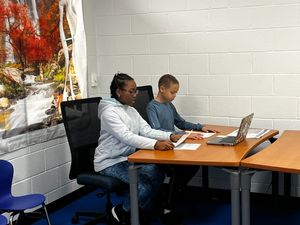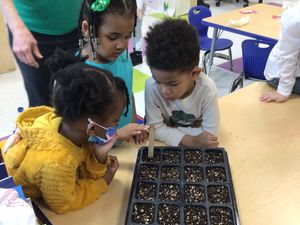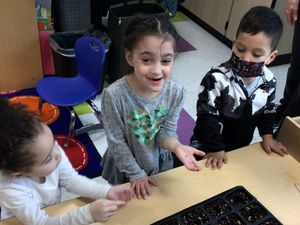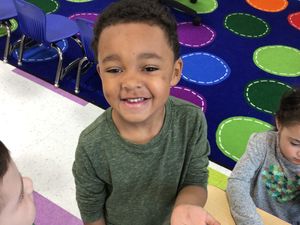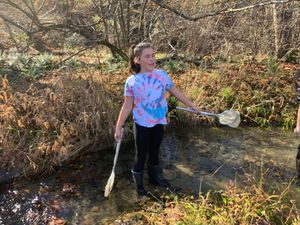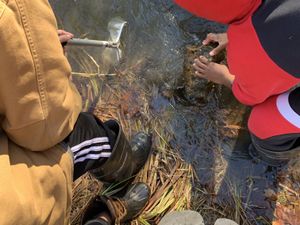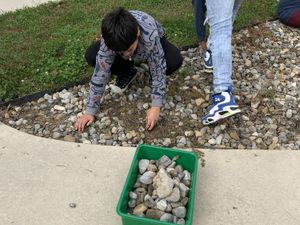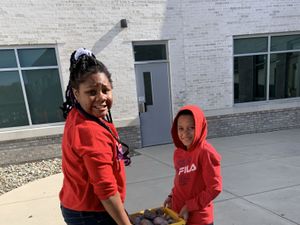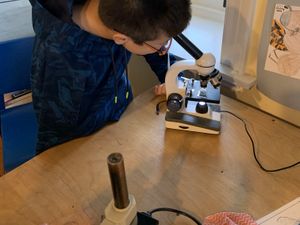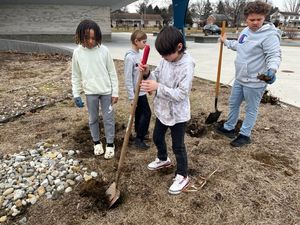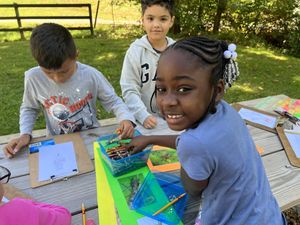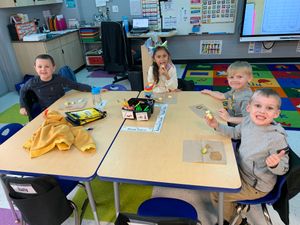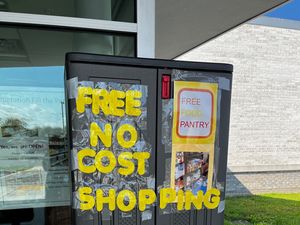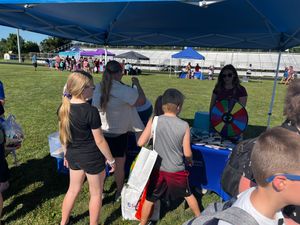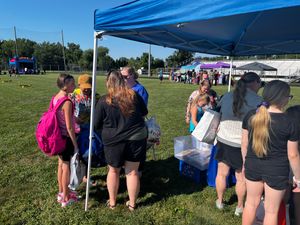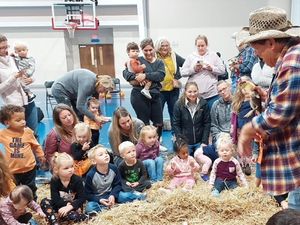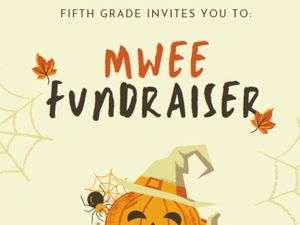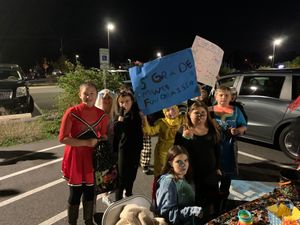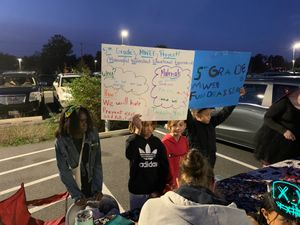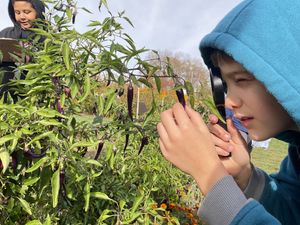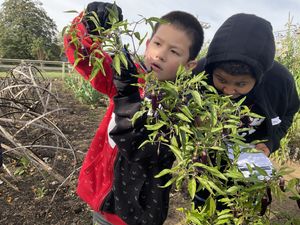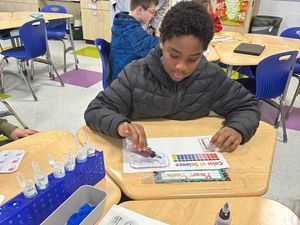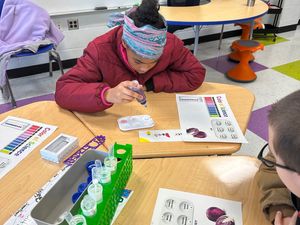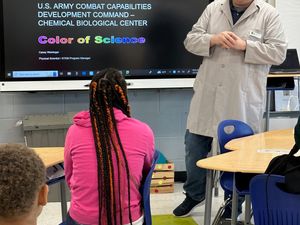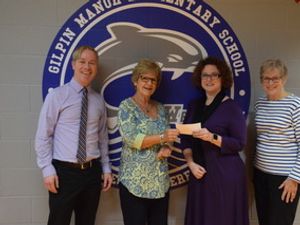Systemic Sustainability
Environmental Curriculum and Instruction
1.1 Curriculum and Instruction
Elementary & middle schools must provide one example of outdoor/environmental instruction per grade level.
High schools must provide one example of outdoor/environmental instruction in four subjects (which may include multiple different differents sciences).
In this lesson, students identify the basic needs of plants and animals (food, shelter, air, water).
Teacher demonstrating to class the life cycle of a plant.
Outdoor learning about the life cycle of plants.
Students watching their worm habitat for observation.
Gr1 MP1 ILW Lesson1_ External Parts to Meet Needs Lesson Plan (2.48 MB)
In this lesson, the students identified the basic needs of plants and animals. They extended the lesson further by growing pumpkins from seeds.
In this lesson, students make observations about the plants and animals in their habitat. This is a new lesson created because the standard for this part of this unit focuses on habitats and how different life cycle stages the organism may use a different habitat. In past years, this was not the focus of the lessons and so this lesson was created to establish and introduce what a habitat is before students dive deeper into plant and animal life cycles.
Second grade students are examining their natural habitat for various insects while working in an outdoor classroom.
Second grade students are examining their natural habitat for various insects while working in an outdoor classroom.
Truth About Habitats reading passage (7.6 MB)
Reading Passage for the Lesson Plan Shared.
Gr2 MP1 Lesson 8 Google Slides (2.38 MB)
Google Slides used to Teach Lesson 8.
Gr2 MP1B LC Lesson 8 Plan - Where do organisms live (122.68 KB)
Lesson plan on Habitats for Grade 2.
In this lesson, students make a claim about the merit of a solution to a problem caused when the environment changes and the types of plants and animals that live there may change. Students define ecosystem and the levels of organization in an ecosystem and began naming the nonliving (abiotic) and the living (biotic) things found in an ecosystem. Students write to explain the levels of an ecosystem and what effects may occur if the ecosystem was to change.
Students explore local floral habitats/ecosystems.
Students located a bee on their floral habitat journey.
Students are investigating various floral habitats for evidence of living organisms.
Gr3 MP1A Lesson 5 Google Slides (1.69 MB)
Google Slides used to teach Lesson 5.
Gr3 MP1A SOL Lesson Plan 5 - Ecosystem_ Habitats for Living Things (1.46 MB)
Lesson plan taught to Grade 3 about Ecosystems and Habitats.
In this lesson, students make observations and measurements to provide evidence of the effects of weathering or the rate of erosion by water, ice, wind, or vegetation. Students identify and describe weathering and erosion. Students demonstrate the effects of weathering and erosion on soil within a lab.
Data collection for the lab on weathering and erosion.
Data collection chart.
Student collecting data.
Grade 4 erosion demonstration.
Grade 4 erosion demonstration.
Grade 4 weathering demonstration.
Grade 4 weathering demonstration with sand.
Grade 4 weathering demonstration.
Weathering & Erosion - Glacier Lab Google Slides (426.57 KB)
Weather and Erosion Glacier Lab.
Weathering & Erosion - 14 Stations Lab Google Slides (1.22 MB)
Station Rotations for the Lab.
Option #2 - Weathering and Erosion Glacier Lab (100.14 KB)
Weathering and Erosion optional enrichment lesson.
Option #2 - Glacier Lab Student Lab Sheets (54.54 KB)
Optional enrichment lesson for the student lab.
Option #1 - Weathering Erosion Lab Student Sheets (60.06 KB)
Optional Enrichment weathering and erosion lab.
Option #1 - Investigating Weathering & Erosion Lab Stations (106.23 KB)
Investigating weathering lab.
G4 MP1B ECS Lesson 14 Plan - Weathering and Erosion Lab (138.32 KB)
Lesson plan for weathering and erosion lab.
Gilpin Manor Elementary School provided a public schools comprehensive, multi-disciplinary environmental literacy program infused within current curricular offerings and aligned with the Maryland Environmental Literacy Standards. The Meaningful Watershed Educational Experience (MWEE) is a learner-centered framework that focuses on investigations into environmental issues and leads to informed action. MWEEs are made up of multiple components that include learning both outdoors and in the classroom and are designed to increase environmental literacy by actively engaging students in building knowledge and meaning through hands-on experiences. In these experiences, the core ideas and practices of multiple disciplines are applied to make sense of the relationships between the natural world and society. MWEEs help connect students with their local environment and equip them to make decisions and take actions that contribute to stronger, sustainable, and equitable communities.
5th Graders experiment with oil pollution and methods to contain it from spreading.
5th Graders experiment with oil pollution and methods to contain it from spreading.
5th Graders experiment with oil pollution and methods to contain it from spreading. 5th Graders document their learning.
Students created their own fundraiser flyer that was electronically shared with parents and the community to raise money for the green school project of a creation of a natural habitat for birds and butterflies.
Students created their own fundraiser to raise money for the green school project of a creation of a natural habitat for birds and butterflies.
Students created their own fundraiser to raise money for the green school project of a creation of a natural habitat for birds and butterflies.
Fifth grade students created their own fundraiser to raise money for the green school project of a creation of a natural habitat for birds and butterflies.
Students created their own fundraiser to raise money for the green school project of a creation of a natural habitat for birds and butterflies.
Fifth Grade students learn in an outdoor classroom.
Fifth Grade students learn in an outdoor classroom.
Students examine and analyze local creek water samples for healthy organisms.
Students examine and analyze local creek water samples for healthy organisms.
MWEE Integration With Grade 5 Science Curriculum (125.93 KB)
Grade 5 Scope and Sequence for the MWEE integration lessons.
MWEE Gr 5 MP1 (270.17 KB)
5th Grade Lesson plan for the MWEE unit. This plan integrates students identifying their own school community needs for an environmental change.
Students in PreK work hard during the end of February and early March to create birdhouses for the outdoor classrooms and no mow zones. These bird houses happen throughout the entire week. See attached lesson plan (Week 29, Week 5 - Second and Third Page).
PreK students make bird feeders to hang around the school grounds; and then celebrate their successes.
22-23 Pre-K Trimester 3 Scope and Sequence (191.08 KB)
Students in PreK work hard during the end of February and early March to create birdhouses for the outdoor classrooms and no mow zones. These bird houses happen throughout the entire week. See attached lesson plan (Week 29, Week 5 - Second and Third Page).
In this lesson, children in Kindergarten learn that organisms have basic needs, Organisms can survive only in environments in which their needs can be met. Each animal has different structures that serve different functions in growth and survival. Animals have life cycle including birth, maturation, reproduction and death. Animals closely resemble their parents. They can observe with all five of our senses. Observation is the act of gathering information about something through our senses. When the students observe they record what they experience like capturing a photograph with a camera. Attached is just on of the unit lessons. The students then go to a far to release the chicks into a stable environment where their needs are met.
Caring for Chicks in the Classroom Lesson (97.48 KB)
Kindergarteners learn about the life cycle of a chick from egg to hatched chick.
1.2 Green School Awareness
1.2.1 School Wide Awareness - Staff
Demonstrate that all school personnel are aware of your school's Green School status and application process.
The staff was introduced to the Green School application process at a staff school improvement team meeting. The staff was informed on ways they can support the school's environmental literacy plan and ways to document what they are already doing in their classrooms. The presentation was presented on 09/14/2022. Staff was involved in brainstorming other ways that they can help their children become involved in the green school process.
The staff was introduced to the Green School application process at a staff school improvement team meeting with the presentation below. The staff was informed on ways they can support the school's environmental literacy plan and ways to document what they are already doing in their classrooms. The presentation was presented on 09/14/2022 to 52 staff member (see attached).
This is a picture from the professional development about the Green School Process with the staff of Gilpin Manor Elementary on 09/14/2022.
Submission GMES Green School PD 9-14-22 (701.31 KB)
This is the presentation presented to the staff on 09/14/2022 in our school improvement team meeting to 52 staff members.
Green School PD Sign In (231.54 KB)
This document is the sign in sheet for the professional development Green School presentation to the staff on 09/14/2022.
1.2.2 School-Wide Celebration
Demonstrate how your school celebrates beig a Green School by hosting a school-wide environmentally-focused event open to all students.
We have held Earth Day Celebrations at Gilpin Manor to help in completing a lot of our environmental projects. This event included over 469 students that created various items for our school to also include awareness of environmental issues with the community. The students were awarded certificates for completion of their green initiatives and hard work to create a Green School.
For Earth Day 2022, the students of Gilpin Manor celebrated all of their green school accomplishments, which include bird feeders, trash clean up, recycled material bird houses, and collections of batteries, ink cartridges, and more. The students shared their next steps, which included the outdoor classroom to be completed in 2023. The students also celebrated their new habitat restoration with the community. Over 469 students and community members participated. Students were given certificates for the completion of the projects.
Another Earth Day Celebration with Certificates is planned for April 21, 2023.
Earth Day Certificate (86.83 KB)
Certificate from Earth Day 2022 Celebration (One Example) given to 469 students.
Environmental Professional Development for Teachers
1.3.1 Environmental Professional Development for Teachers
Demonstrate that 10% of staff have completed an environmental PD. Instructional staff is defined as any staff that manages a gradebook.
- New Schools must have all PD completed within the past 2 academic years.
- Renewing schools must have all PD completed within the past 4 academic years.
A teacher who has participated in multiple workshops may only be counted once..
This year the Grade 5 science teachers were trained on how to get students to participate in a culminating project as part of MWEE (Meaningful Watershed Educational Experience). This is slated for the period subsequent to MISA, which incidentally will not take away, but enhance students’ knowledge towards environmental literacy consistent with Maryland Environmental Literacy Standards. These MWEE lessons have been integrated into the current curriculum systematically with an outcome that does not necessarily increase or detract from existing curriculum. This was elaborated on during the F2F presentation on 8/30/2022. Attended by Rachel Clewer, Grade 5 Teacher, on 08/30/2022 from 10:30AM-11:30AM.
This year, science teachers in grade 2 were professionally developed on the opportunity to integrate evidence based writing practices currently suffused in their book worms. This strategy is being piloted in grade 2 with the expectation of generalizing to other grades in the future. The transference of these writing skills will enhance students’ writing of informative and explanatory texts. A video presentation by Andrea Lutholtz as part of an asynchronous activity in Schoology cites real examples from existing science curriculum with soil compositions and systematically presents how these processes may be utilized. This training was held on 08/29/2022 from 8:00AM-12:15PM. Attended by Kayce Strickland, Colleen Gaughran, and Gretchen Paris, Grade 2 Teachers, on 08/29/2022 from 8:00AM-12:15PM.
Robin Lane-Cragle attended a Watershed Academy to learn ways that the schools can protect our watershed.
Grade 5 teachers were given environmental professional development by the county coordinators at the beginning of the school year. This included a new Maryland Watershed Environment Education component and soil study.
August 2022_Coordinator PD with time and location (307.97 KB)
Training Agenda for the teachers involved in the pre-service trainings with Cecil County Public Schools.
Robin Lane-Cragle attended a Watershed Academy to learn ways that the schools can protect our watershed. This professional development taught ways to engage students in the importance of our watershed.
Watershed Training Certificate (656.43 KB)
This certificate was awarded to Robin Lane-Cragle for her participation in the Watershed Academy.
Lori Pitcock attended the MEGS (Maryland Educators of Gifted Students) conference on October 14 and 21, 2022. At this conference, she attended a session entitled "Using Green Education to Help Gifted Children Find Their Voice: How Sustainability/Environmental Investigations Can Build STEM Skills." Throughout this presentation the presenters explained with the awareness of sustainability and environmental degradation is at an all-time high. By merging the issues with inquiry, differentiation, and independent study, gifted students can engage in rigorous curriculum that also meets their social and emotional interests while also building their critical and creative thinking skills in STEM areas.
Pitcock_2022 MEGS Certificate_Attendee (654.51 KB)
Certificate of Attendance to the 2022 MEGS conference.
Proof of MEGS Attendance (772.79 KB)
Proof of MEGS Conference Attendance Approval.
Grade 2 teachers were given environmental professional development by the county coordinators at the beginning of the school year. This included a new Maryland Watershed Environment Education component and soil study.
August 2022_Coordinator PD with time and location (307.97 KB)
Grade 2 teachers were given environmental professional development by the county coordinators at the beginning of the school year. This included a new Maryland Watershed Environment Education component and soil study.
Grade 2 teachers were given environmental professional development by the county coordinators at the beginning of the school year. This included a new Maryland Watershed Environment Education component and soil study.
August 2022_Coordinator PD with time and location (307.97 KB)
Grade 2 teachers were given environmental professional development by the county coordinators at the beginning of the school year. This included a new Maryland Watershed Environment Education component and soil study.
Grade 2 teachers were given environmental professional development by the county coordinators at the beginning of the school year. This included a new Maryland Watershed Environment Education component and soil study.
August 2022_Coordinator PD with time and location (307.97 KB)
Grade 2 teachers were given environmental professional development by the county coordinators at the beginning of the school year. This included a new Maryland Watershed Environment Education component and soil study.
1.4 Achieving Sustainable Schools
1.4.1 School-Wide Staff Sustainability
Demonstrate the sustainability practices your teachers, staff, and other personnel have implemented school-wide to make your school green. Any actions involving students belong under Objective 2.
Non-student sustainability practices are vital to the Green School Application. Our staff at Gilpin Manor Elementary has demonstrated many green actions. We have installed refillable water bottle fountains, sensored lights, impervious pavement, no mow zones, and many other actions. Many of our teachers have begun teaching with the natural light and not using classroom lights in their classrooms during instruction to save on electricity. Our administrative team has been distributing newsletters and updates for staff and parents electronically to save on paper consumption.
Students in 1st Grade have changed their behavior to save energy by working in the natural light.
Students in Kindergarten have changed their behavior to save energy by working in the natural light.
Plants of various types have been added to our building to improve the indoor air quality.
Solar powered lights are used outside. This device is capturing the sun light for another external light.
Gilpin Manor had water bottle refill stations added to the school.
This is an example of a flyer going home to our families electronically through Class Dojo from our principal about the Meet the Teacher Social. All communication with parents is electronic through email, Class Dojo, text messages, or phone calls to reduce paper consumption.
Staff participate in energy conservation activities by keeping the lights off in offices and conference rooms, while using natural light.
Staff participate in energy conservation activities by keeping the lights off in offices and conference rooms, while using natural light.
Gilpin Gazette - September 2 - 2022 (1.19 MB)
This document is one of the weekly newsletters sent to the staff via email to reduce on paper use. All communication with staff is by electronic means. Agendas to meetings, newsletters, and any schedules are completed electronically.
GRADE 4 - MP 1, 22-23 (366.36 KB)
This is an electronic newsletter to the fourth grade families shared via Class Dojo and email.
GRADE 1 - MP 1, 22-23 (345.74 KB)
This is an electronic newsletter to the first grade families shared via Class Dojo and email.
1.4.2 Systemic Partnership
Demonstrate one partnership with a central office or board within the school system that supports part of the Maryland Green Schools Program. Any partnerships outside of your school system belong under Objective 3.
In March of 2021, Dr. Mashongamhende and the Green School Facilitator (Dr. Pitcock) joined forces in a partnership to support the green school initiative application. Dr. Mashongamhende is the Director of Science for Cecil County Public Schools and is located at our Central Office Building. This partnership has continued as we work to complete our application process.
Student Action
Schools must document eight total actions that address at least three of the listed sustainability practices.
These are student actions not adult actions. Adult sustainable actions can be documented in Objective 1.4.
2.1 Water Conservation/Pollution Prevention
2.1 Water Conservation/Pollution Prevention
The Kindergarten students at Gilpin Manor Elementary School spent time outside gathering litter from the school grounds. The students were identifying pollution and waste. Their teacher (Mrs. Moore) completed a lesson on keeping the environment clean.
The school engaged in a water challenge to drink fresh water and prevent pollution by using reusable bottles. These were supplied by the school to all students. Students monitored their own use and refilling habits as a study. Students presented results to classroom teachers. Students encouraged the teachers to also engage in this activity. Students are located in the cafeteria with the lights off and the use of natural light to share their water bottle pictures.
Students each lunch in the cafeteria in the natural light with reusable water bottles.
Water Bottle Use and Reusable Lunch Trays.
Teachers participating in the student challenge.
Student using the reusable bottle.
Students using their refillable bottles and enjoying some fresh lemon supplied to us by a local market.
Students in Grades 4 and 5 worked with the local conservation team from the county and the water works system to develop a no-mow zone to build a natural habitat.
2.2 Energy Conservation
2.2 Energy Conservation
Students are monitoring the daily use of energy in their classrooms by recommending or reminding their teachers to use natural light as often as possible.
Energy Conservation - Students and Teachers are reducing the use of energy (lights) by using natural light as often as possible.
First Grade students are learning by natural light.
Kindergarten students are learning by natural light.
Students in the fifth grade conserve energy by learning with natural light.
The students enjoy their lunches in the cafeteria with the use of natural light from the windows on reusable trays.
2.3 Solid Waste Reduction
2.3 Solid Waste Reduction
Students promoted the use of reusable trays to reduce waste from the previously used disposable trays.
Students repurposed used materials into art projects via a book with ripped pages.
Students in Grade 5 created a no-waste lunch Wednesday schedule to reduce waste of lunch trash and promote reusable containers.
Students present to various classrooms about the No Waste Wednesdays and why it is so important for our environment.
gilpin gazzete for staff (24.13 KB)
This document was created by the 5th graders to promote no-waste lunch Wednesdays to the Staff to be placed in the digital newsletter.
No WASTE Wednesday 3rd and 4th Grade (1.28 MB)
This is an example of a fifth graders presentation to promote the no-waste lunch Wednesdays to the 3rd and 4th graders.
Dolphin Digest _ Smore Newsletters (8.07 MB)
This is a digital copy of the newsletter that goes home to the parent/guardian community for our school weekly. About mid-way down you will see the information about the no-waste Wednesdays.
Students in grade 4 and 5 worked together to develop a ink cartridge recycling program for Gilpin Manor Elementary to reduce environmental impacts.
Dolphin Digest _ Smore Newsletters (8.07 MB)
This is a digital copy of the newsletter that goes home to the parent/guardian community for our school weekly. About mid-way down you will see the information about the ink cartridge recycling program.
INK CARTRIDGE (534.09 KB)
This document was created by the 4th and 5th graders to promote ink cartridge collections to the Staff to be placed in the digital newsletter.
2.4 Habitat Restoration
2.4 Habitat Restoration
The preschool class is excited to be planting native plants in their pods that will be later transferred to the school grounds to help prevent erosion.
Preschool students are planting native plants in their classroom.
Preschool students are planting native plants in their classroom.
Preschool students are planting native plants in their classroom.
Students in Preschool are given seeds to plant in their classroom.
This young man in preschool is super excited to plant a seed in his classroom.
Students participated in creating bird feeders, bird houses, and installation of butterfly bushes, a rock garden, bird houses, no mow zones, and more. The students worked hard to create these various green areas, which included an outdoor classroom with picnic tables, water tables, and more for students to use and participate in learning.
PreK worked to create edible bird feeders to be hung outside for our native birds to enjoy.
Fifth graders were testing water found near the school to determine if it was polluted.
Students collect samples from the creek to analyze it for pollutants.
Students collect trash from the creek.
Students look for water samples to look for healthy organisms.
Students remove the rocks from a rock garden to create an outdoor classroom area in that location.
Students work to remove the rocks from a rock garden to create an outdoor classroom area in that location.
Students remove trash from the creek.
Students move the rocks to a new location on the school grounds to repurpose their use from a previous rock garden.
Students participated in water analysis of a local creek to identify organisms that are healthy for the creek's overall health.
Students created bird houses to be placed in our habitat restoration area at the front of the building with our butterfly bushes.
Students work together to build bird houses for the restoration habitat area.
Students work together to build bird houses for the restoration habitat area.
Students work together to build bird houses for the restoration habitat area.
Students work together to build bird houses for the restoration habitat area.
Students work together to remove invasive species from the new habitat restoration area, which will include new butterfly bushes, bird houses, bird feeders, river rocks and native plants.
2.5 Opportunities for Nature Exploration
2.5 Opportunities for Nature Exploration
Students in grades 2-5 have had their learning changed dramatically. Chromebooks have been deployed to classrooms to support online learning and engagement. Students utilize the Chromebooks to research content, engage in interactive activities, and submit work to their teachers through Google Drive and Schoology. Chromebooks use less energy than traditional desktop computers and their charge can last an extended time period. Utilizing Chromebooks also cuts down on the number of paper copies of assignments that would need to be run through the copiers.
Students use picnic tables to have opportunities to work outside and learn in their natural environment.
Students participated in water analysis of a local creek to identify organisms that are healthy for the creek's overall health.
2.6 Responsible Transportation
2.6 Responsible Transportation
Students went on a walking field trip to a local theater to reduce their carbon footprint and get to know local ecosystems, emphasizing the effects on climate change on their way.
Students in grades 3, 4, and 5 took a walking field trip to see Matilda at a local theater. This eliminated a bus trip and limited the carbon footprint.
Students in grades 3, 4, and 5 took a walking field trip to see Matilda at a local theater. This eliminated a bus trip and limited the carbon footprint.
2.7 Healthy Indoor Environments
2.7 Healthy Indoor Environments
The event that is held every year around the time of Thanksgiving promotes healthy habits, while also gathering non-perishable food for our community and families. The students donate the canned items and run to raise awareness of those in need. This year, we threw a twist into it and are also adding the Green Run portion to raise money for our environmental education projects and our community garden.
Students added a twist to the normal Turkey Trot that is held annually. This year they added a Green Run portion to raise money for their environmental projects.
Students added a twist to the normal Turkey Trot that is held annually. This year they added a Green Run portion to raise money for their environmental projects.
GMES Turkey Trot (3.49 MB)
Students use the school grounds to get healthy.
2.8 Citzen/Community/Participatory Science
2.8 Citizen/Community/Participatory Science
No records were added by the school.
Community Partnership
Demonstrate that your school is forming long-term partnerships to foster environmental stewardship and cultivate community wellness through real-world connections.
3.1 Community Partnerships
3.1.1 School Active in Community
Describe at least one environmentally-focused partnership in which your school is working to benefit your community.
The students of Gilpin Manor have worked diligently to organize and collect gently used clothing for our Community Pantry. This is a location where families in need can obtain items for their family. The students also do a canned food drive to support families in need of food.
Gilpin Manor Elementary School sat up a tent for the local community at the back to school community event. At this location, staff played games with kids, gave out free books, and other school supplies while engaging with family members. A fun day was had by all.
Staff participated in a back to school community event that allowed our local families and communities get the resources needed to begin the school year on the right foot.
Staff handed out bookbags, activity sets, school supplies, and books for anyone in the local community that needed something for the start of school.
Families were engaged with the Gilpin staff as they received items they needed to start school.
Parents and students reconnected with local community organizations and the school staff before school began.
Staff participated in a back to school community event that allowed our local families and communities get the resources needed to begin the school year on the right foot.
The Judy Center partnership held the Pumpkin Patch event at the Neighborhood Community Center for families of children ages2-4. Families enjoyed a magic show, held baby ducks and chick, pet rabbits, and made scarecrows to take home.
The local Judy Center brings in a local farmer to talk with young children and their parents about the importance of fresh produce and animals.
Young children participate in learning about the farm at the Judy Center Event.
The local Judy Center brings in a local farmer to talk with young children and their parents about the importance of fresh produce and animals.
The fifth grade students at Gilpin Manor held a fundraiser event at the Trunk or Treat to support their environmental initiatives related to the Meaningful Watershed Educational Experience (MWEE). The students used a guess the candy corn game with participants to raise money for their environmental project materials. The students raised over $200 at the event.
The flyer promoting the fundraiser by our 5th grade students to support their MWEE projects.
Students at the fundraiser with their handmade signs.
Students at the fundraiser with their handmade signs.
Students at the fundraiser with their handmade signs.
Students at the fundraiser with their handmade signs.
The kindergarteners went to the local public library to explore the resources and practice with their digital library cards. Students use the wall at the public library to explore the waterways of Maryland and how the watershed works.
Students went to a local garden not far from the Cecil County line to learn about local plants and native species appropriate for the outdoor classroom.
3.1.2 Community Active in the School
Describe at least one partnership in which a community partner is benefitting the school. These actions and projects occur on or near school grounds with support from the partner.
Grandparents were welcomed into the school to participate in lessons with their grandchild. These lessons often included environmental science. The event was open to the entire school.
The Singerly Fire Company of Elkton presented to the entire school about fire safety over the course of two days. The children were given activity books and materials to make a map. The children were able to climb onto the fire truck.
The Elkton YES Organization works with Gilpin Manor Elementary School to build stronger families in the county. This program provides childcare, so parents can attend parenting workshops (specifically about Trauma). The program supplies dinner and transportation for our families. Service learning credits are also available to parents through this program. Teachers are also at the event to lead activities with the children, while the parents learn. This is a great example of the community working closely with our school.
The Community was invited into the school to assist students paint rocks for our new rock garden with the repurposed rocks from a previous rock garden.
Community members paint rocks for the new rock garden.
Community members paint rocks for the new rock garden.
Parents also assisted in painting rocks for the new rock garden.
Examples of some of the rocks painted for our newly installed rock garden.
Examples of some of the rocks painted for our newly installed rock garden.
Students received a presentation from the local editor of the Cecil Whig (local newspaper) about the importance of conserving paper and appropriate reporting.
The Development Command of the Chemical Biological Center of the U.S. Army came to the school to present about the importance of environmental friendly weapons and how water is a vital component to make batteries more natural.
DEVCOM presented to the class about the appropriate use of environmental friendly weapons in war.
DEVCOM presented about static electricity.
DEVCOM presented about the importance of water in power.
Students engaged in creating their own working battery out of water.
Students engaged in creating their own working battery out of water.
DEVCOM returned to the school to teach the students about acid in the environment and the impact acidity has on various habitats.
3.2 Additional Achievements
3.2 Additional Achievements optional
Share any environmentally-related awards, special recognition, certifications, or other achievements that your school, staff or students have accomplished.
The school was awarded $200 for the Bird and Butterfly Habitat Installation Project set to benefit the entire school through the environmental literacy standards. The goal of the project is to purchase and install Butterfly bushes and Butterfly Weed, as well as Bird Boxes in the outdoor classroom setting developed by the students of Gilpin Manor Elementary School. The project will be a sanctuary for local, native wildlife, which will allow the students to observe and monitor migration habits and will be home to an outdoor classroom for all 472 students and teachers.
Dr. Lori Pitcock (Awardee) and Dr. Donald Foskey (Principal) are pictured as they are awarded the $200 grant received for the Bird and Butterfly Habitat Installation Project at Gilpin Manor Elementary School.
CCCRSPA Award (4.95 KB)
Email of acknowledgement of receiving the grant money for the Bird and Butterfly Habitat Installation Project.


